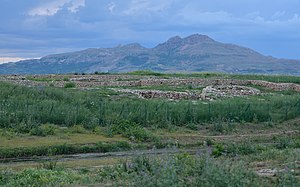卡育努
 卡育努遗址 | |
| 地點 | 土耳其迪亚巴克尔省 |
|---|---|
| 坐標 | 38°12′59″N 39°43′35″E / 38.21639°N 39.72639°E坐标:38°12′59″N 39°43′35″E / 38.21639°N 39.72639°E |
| 類型 | Settlement |
| 歷史 | |
| 建立於 | 8,630 BC[1] |
| 廢棄於 | 6,800 BC[1] |
| 時代 | 新石器时代 |
卡育努遗址(英語:Çayönü Tepesi)是土耳其东南部的一个新石器时代的定居点遗址,它曾在大约在公元前8630年至公元前6800年期间繁荣一时。[1]它位于迪亚巴克尔西北40公里处的陶鲁斯山脉脚下、底格里斯河上游支流博阿兹查伊河(Boğazçay)和间歇性河流贝斯塔科特河(Bestakot)附近。
考古[编辑]



该遗址在1964年至1991年期间历经了16轮的挖掘,最初由考古学家罗伯特·约翰·布雷德伍德和哈雷特·坎贝尔Halet Çambel发掘,后来穆罕默德·厄兹多安和阿斯勒·埃里姆·厄兹多安也加入到发掘工作中。[2][3]该定居点涵盖了前陶器新石器时代A阶段(PPNA)、前陶器新石器时代B阶段(PPNB)和陶器新石器时代(PN)等时期。
该地层根据主要建筑结构分为以下几个亚阶段:[4]
- 圆式结构,PPNA
- 栅栏式结构,PPNA
- 通道式结构,早期PPNB
- 鹅卵石铺砌结构,中期PPNB
- 牢房结构,晚期PPNB
- 大房结构,最晚期PPNB
考古学家对遗址中发现的血迹进行分析,数据表明这里曾发生过人祭。[5]
驯化遗迹[编辑]
动物[编辑]
卡育努可能是猪(Sus scrofa)首次被驯化的地方。[6]
谷物种植[编辑]
对埃默尔小麦(目前大多数小麦品种的前身)的遗传学研究表明,它显示与恰耶努相邻的卡拉卡山的山坡是小麦首次被驯化的地点。另一种DNA方法,也指向卡拉卡山。[7]
罗伯特·约翰·布雷德伍德在1972年对该遗址土地进行深度测试,并称该测试表明卡育努作为史前遗址,在新石器时代早期即具备栽培埃默尔小麦的能力。[8]
相关[编辑]
参考[编辑]
- ^ 1.0 1.1 1.2 Collins, Andrew. Gobekli Tepe: Genesis of the Gods: The Temple of the Watchers and the Discovery of Eden. Simon and Schuster. 2014: 93 [2021-09-22]. ISBN 9781591438359. (原始内容存档于2020-07-27) (英语).
- ^ Çambel, H.; Braidwood, R. J. (编). The Joint Istanbul-Chicago Universities' Prehistoric Research in Southeastern Anatolia. Istanbul University Publications 2589. Istanbul. 1980. OCLC 15163668.
- ^ Özdoğan, A. Çayönü. Özdoğan, M.; Başgelen, N. (编). Neolithic in Turkey: The Cradle of Civilization, New Discoveries. Istanbul: EGE Yayınları. 1999: 35–64. ISBN 975-6899-41-7.
- ^ Pearson, J; Grove, M; Ozbek, M; Hongo, H. Food and social complexity at Çayönü Tepesi, southeastern Anatolia: Stable isotope evidence of differentiation in diet according to burial practice and sex in the early Neolithic. J Anthropol Archaeol. 2013, 32 (2): 180–189. PMC 4066944
 . PMID 24976671. doi:10.1016/j.jaa.2013.01.002.
. PMID 24976671. doi:10.1016/j.jaa.2013.01.002.
- ^ Loy, Thomas H.; Wood, Andrée R. Blood Residue Analysis at Çayönü Tepesi, Turkey. Journal of Field Archaeology. 1989, 16 (4): 451–460. doi:10.1179/jfa.1989.16.4.451.
- ^ Ervynck, A.; et al. Born Free? New Evidence for the Status of Sus scrofa at Neolithic Çayönü Tepesi (Southeastern Anatolia, Turkey). Paléorient. 2001, 27 (2): 47–73. JSTOR 41496617. doi:10.3406/paleo.2001.4731.
- ^ Civáň, Peter; et al. Reticulated Origin of Domesticated Emmer Wheat Supports a Dynamic Model for the Emergence of Agriculture in the Fertile Crescent. PLOS One. 2013, 8 (11): e81955. Bibcode:2013PLoSO...881955C. PMC 3843696
 . PMID 24312385. doi:10.1371/journal.pone.0081955
. PMID 24312385. doi:10.1371/journal.pone.0081955  .
.
- ^ Braidwood, Robert J.; et al. Beginnings of Village-Farming Communities in Southeastern Turkey, 1972. Proc. Natl. Acad. Sci. USA. 1974, 71 (2): 568–572. Bibcode:1974PNAS...71..568B. PMC 388049
 . PMID 16592143. doi:10.1073/pnas.71.2.568
. PMID 16592143. doi:10.1073/pnas.71.2.568  .
.
外部链接[编辑]
| 维基共享资源上的相关多媒体资源:卡育努 |
|
